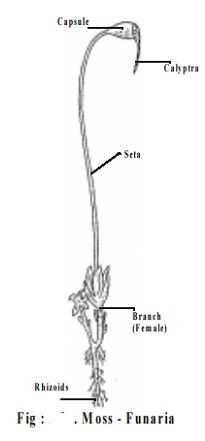Chapter: 11th 12th standard bio zoology Human Body higher secondary school
Classification of Bryophyta

Classification of Bryophyta
Bryophyta is divided into three major classes.
1. Hepaticae Liverworts Eg. Riccia
2. Anthocerotae hornworts eg. Anthoceros
3. Musci Mosss eg.Funaria
1. Class Hepaticae

These are lower forms of Bryophytes. They are more simple in structure than mosses and more confined to damp and shady habitats. They have an undifferentiated thallus. Protonemal stage is absent. Sporophyte is very simple and short lived . In some forms sporophyte is differentiated into foot, seta and capsule. Eg. Marchantia. In some the foot and seta are absent. Eg. Riccia.
2. Class Anthocerotae
Gametophyte is undifferentiated thallus. Rhizoids are unicellular and unbranched. Protonemal stage is absent. Sporophyte is differentiated into foot and capsule and no seta. Eg. Anthoceros.
3. Class Musci
They have a more differentiated structure than liverworts. They often form dense cushions. These are higher forms in which the gametophyte is differentiated into 'stem' like and 'leaf' like parts and the former showing radial symmetry. Rhizoids are multi-cellular and branched. Protonemal stage is present. Sporophyte is differentiated into foot, seta and capsule Eg. Funaria.

Economic Importance
1. Bryophytes form dense mat over the soil and prevent soil erosion.
2. Sphagnum can absorb large amount of water. It is extensively used by gardeners in nursery to keep seedlings and cut plant parts moist during propagation.
3. Peat is a valuable fuel like coal. Mosses like Sphagnum which got compacted and fossilized over the past thousands of years have become peat.
Related Topics